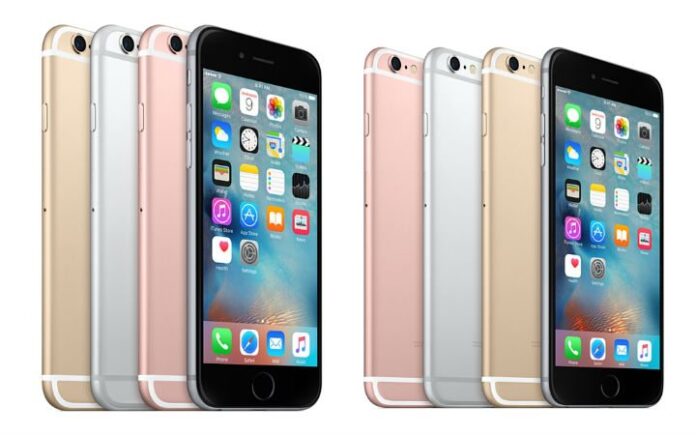Samsung’s Galaxy S7 and Apple’s iPhone 6 highlight the near convergence in camera technology with DSLR cameras
Smartphone cameras today are as good as most point-and-shoot cameras. They can also capture video in 4K – four times the resolution a high-definition TV can display. The future of smartphone cameras is to migrate toward multipoint capture arrays that will enable smartphone cameras to generate photos as good as full-function digital single-lens reflex cameras.
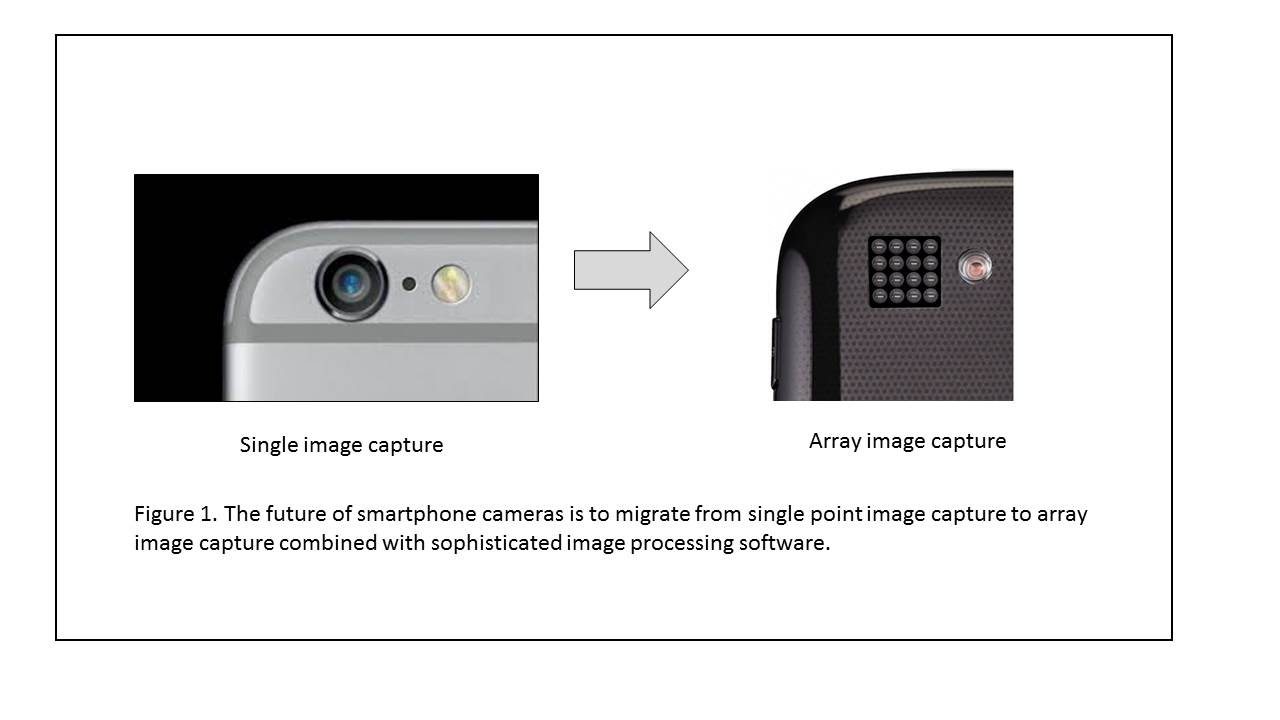
The cameras in most of the popular smartphones such as the Apple iPhone 6s and the 6s Plus along with the just announced Samsung Galaxy S7 and Galaxy S7 Edge take really good photos in most situations. They are now just as good as point-and-shoot cameras (cameras with a built-in lens).
The world of cameras – to take a photo or video – has a wide range of devices that serve basic uses all the way up to professional cameras that can control every aspect of the photo or video. As technology has continued to get better, smartphone cameras have gotten better over the past 10 years. At first, smartphone cameras didn’t have a flash and the digital photos were nowhere as good as a typical point-and-shoot camera and nowhere near as good as DSLR cameras.
When there is a wide range of technology available in the market, you have to judge convenience vs. fidelity to determine if higher fidelity is justified over the convenience. For example, if a smartphone vender offered you the convenience of a smartphone, but with a low-end set of features (e.g. two-megapixel camera, no video) vs. the fidelity of a slightly larger camera with 12 megapixels, five-times optical zoom lens, auto-focus and HD video, you’d likely take the fidelity of the point-and-shoot camera and its associated inconvenience of carting around a separate device because the camera in the smartphone was not good enough for most situations. The point-and-shoot camera is a separate device to carry around and costs $200 to $300.
This was the case in mobile smartphone cameras just a couple of years ago. Many people like me felt it was necessary to carry around a point-and-shoot camera in order to get good, quality digital images when out to dinner or taking daytime photos with the flash fill and taking adequate quality digital videos.
But technology has a way of improving year after year. The new capabilities get inserted most typically in the more costly devices while the older technologies migrate down into the less expensive models. Over the past few years (2014-2016), the smartphone camera gained tremendous fidelity for the same cost. As the smartphone camera became “good enough” for most situations, people gave up their mid-tier point-and-shoot camera and started using their smartphone camera. Today, most smartphone cameras have at least a 10-megapixel image sensor, flash, auto focus and the ability to zoom on the back facing camera and nearly as good a set of specs for the forward facing camera. This has resulted in a large decline in the sales of point-and-shoot cameras.
Now, let’s take a look at the latest specs including the camera in the Samsung Galaxy S7 smartphone:
• 5.1-inch quad HD AMOLED display with “Always On Mode”
• Snapdragon 820 system-on-a-chip
• 4 gigabyte DDR4 random access memory
• 32 GB of internal storage, expandable via microSD card
• 12-megapixel rear camera with “Dual Pixel” technology with f/1.7 aperture
• Five-megapixel front camera, again, with f/1.7 aperture
• 3000-milliampere-hour battery
• IP68 water and dust resistance
• Wireless charging
• Android 6.0.1 Marshmallow
The S7 camera has 12-megapixel image capture chip down from the 16 megapixels in the Galaxy S6. However, this was done to improve the low-light capabilities of the camera. The individual pixels on the camera are now larger with aperture f/1.7 lens that can capture 95% more light. There’s also optical image stabilization to reduce blurring. Samsung also announced “Dual Pixels,” which allows faster autofocus.
The iPhone 6S Plus has the following camera specs:
• 12-megapixel iSight camera with 1.22µ pixels
• ƒ/2.2 aperture
• Live Photos
• Optical image stabilization
• Improved local tone mapping
• Improved noise reduction
• Sapphire crystal lens cover
• True Tone flash
• Backside illumination sensor
• Five-element lens
• Hybrid IR filter
• Autofocus with Focus Pixels
• Tap to focus with Focus Pixels
• Exposure control
• Auto HDR for photos
• Face detection
• Panorama (up to 63 megapixels)
• Auto image stabilization
• Burst mode
• Timer mode
• Photo geotagging
There are a number of areas in which the smartphone camera can be improved, including:
• Focus – change from using one to four or more image capture points. You can then focus at any point in the image or you can blur the background. This will also help in low light situations.
• Flash – variable intensity designed to be most appropriate for the lighting situations and assist with flash fill for daytime photos with the faces of people in the shade.
• Zoom – optical zoom vs. cropping. The use of multiple capture points should help being able to zoom to any point and take full image capture.
• Resolution – this is the number of pixels in which the image is captured in the photo. Most digital cameras today have at least five megapixels, but some have as high as 15 megapixels. There comes a point, however, where more megapixels do not enhance the image. For example, if the image is blurry, you can’t fix the image unless you have multiple image points. It appears to us that the maximum megapixels in a smartphone is around 16 to 20.
Multiple image capture points are shown in two companies that are bringing their solutions to market: Pelican Imaging and Light. These two companies both approach making a better smartphone camera by capturing light from multiple image capture points. Here is a photo of the two solutions provided by Pelican Imaging: (Figure 2)
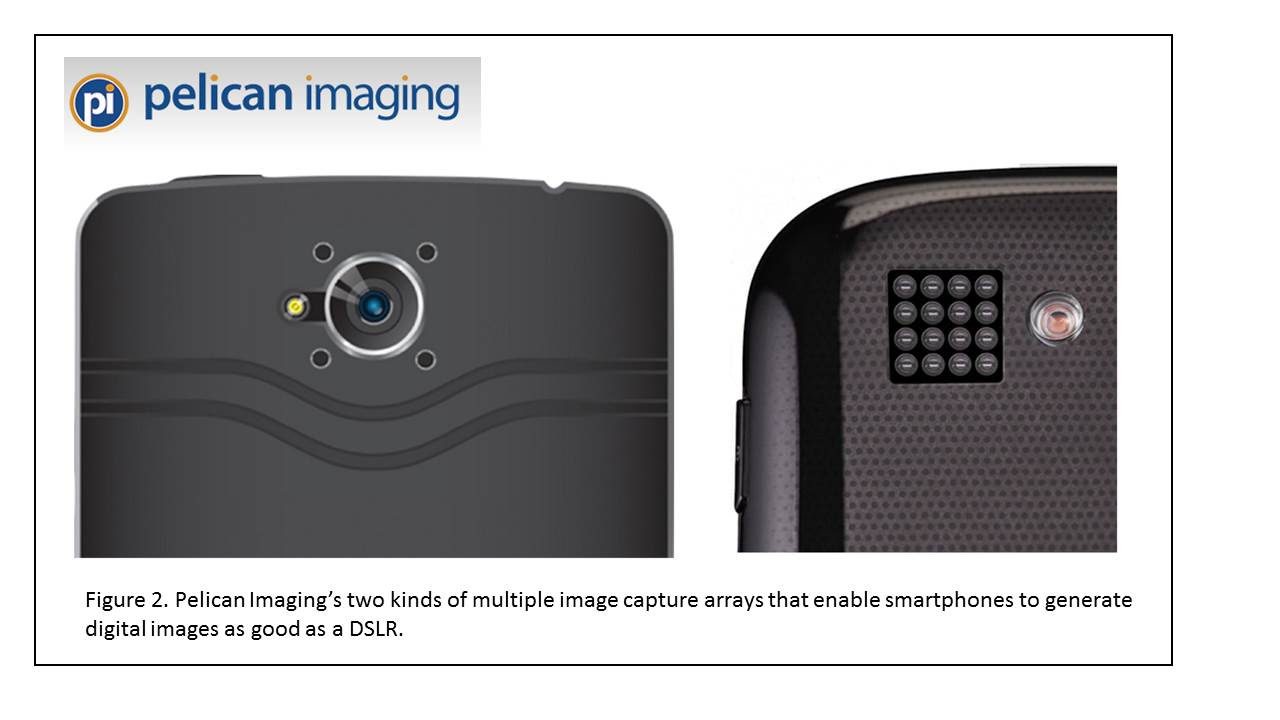
And, here is the Light multiple image capture point camera: (Figure 3)
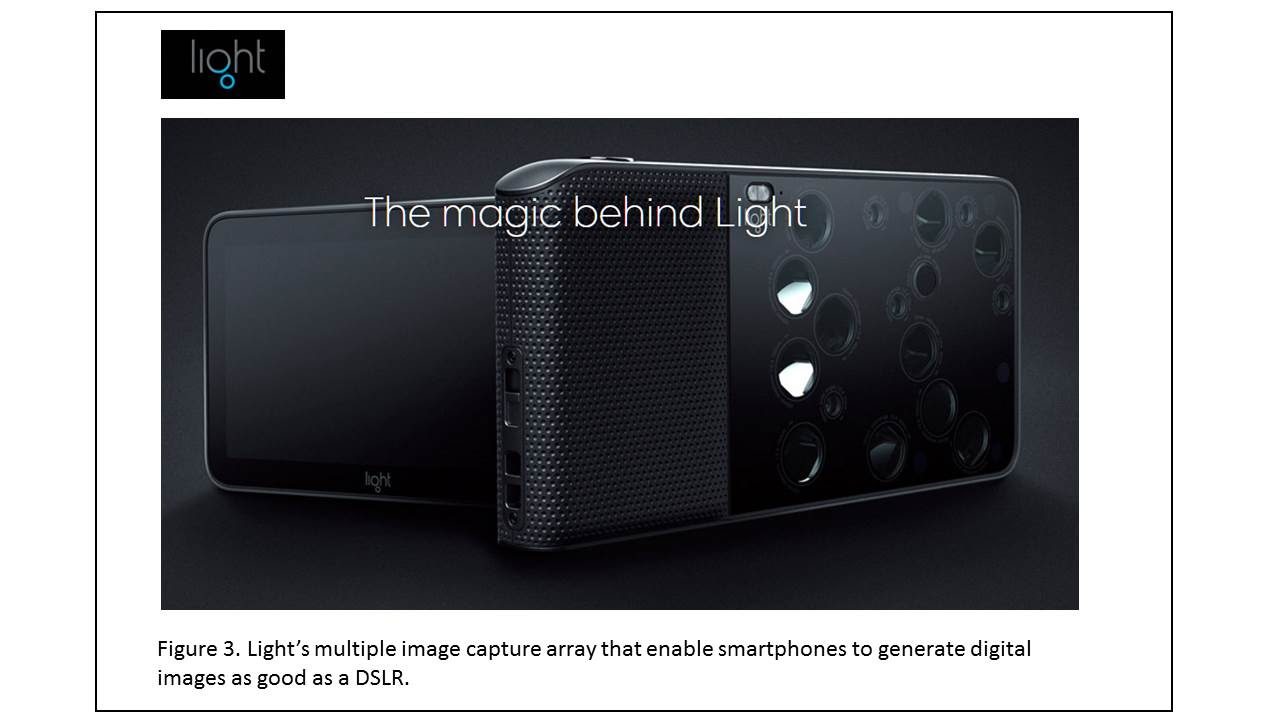
Here is an example of how Pelican Imaging’s array photo capture points can enable dynamic focusing that users can adjust at any time: (Figure 4)

And here is an example of how users can determine how far away objects are in a photo taken by Pelican’s array imaging technology: (Figure 5)
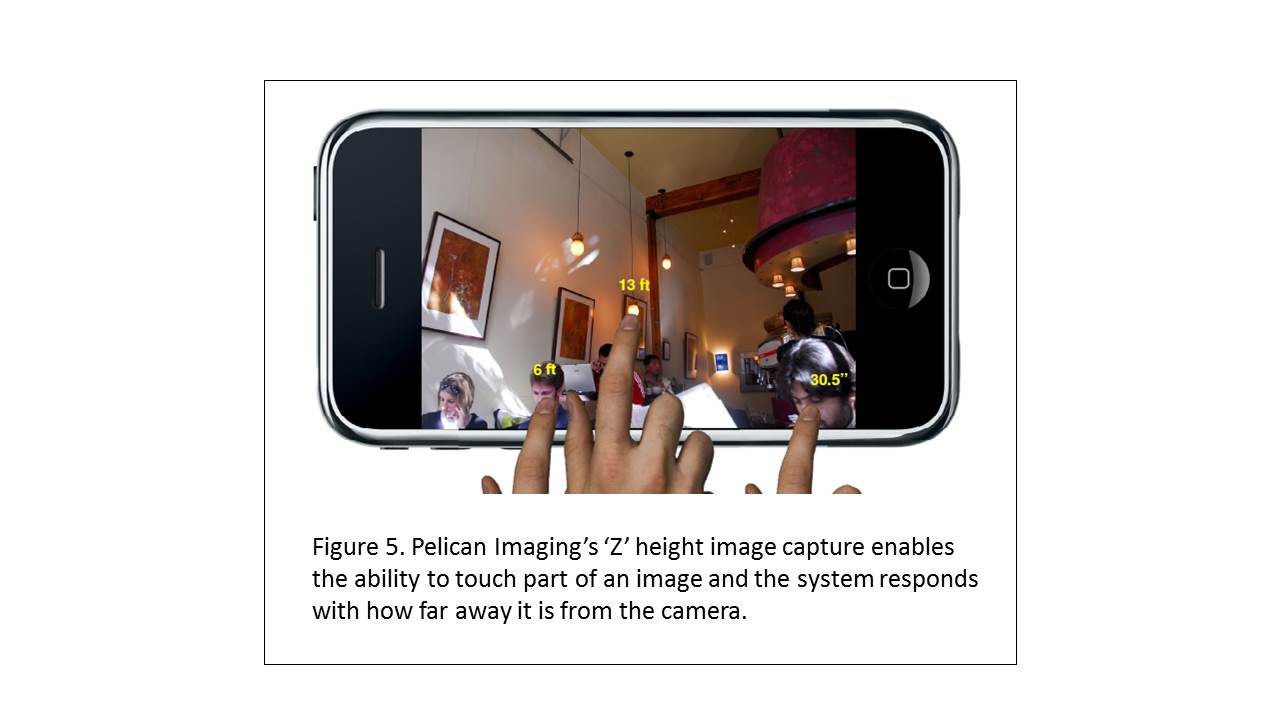
Finally, here is an example of how a really low light image can be enhanced using Pelican Imaging’s low light enhancement software: (Figure 6)
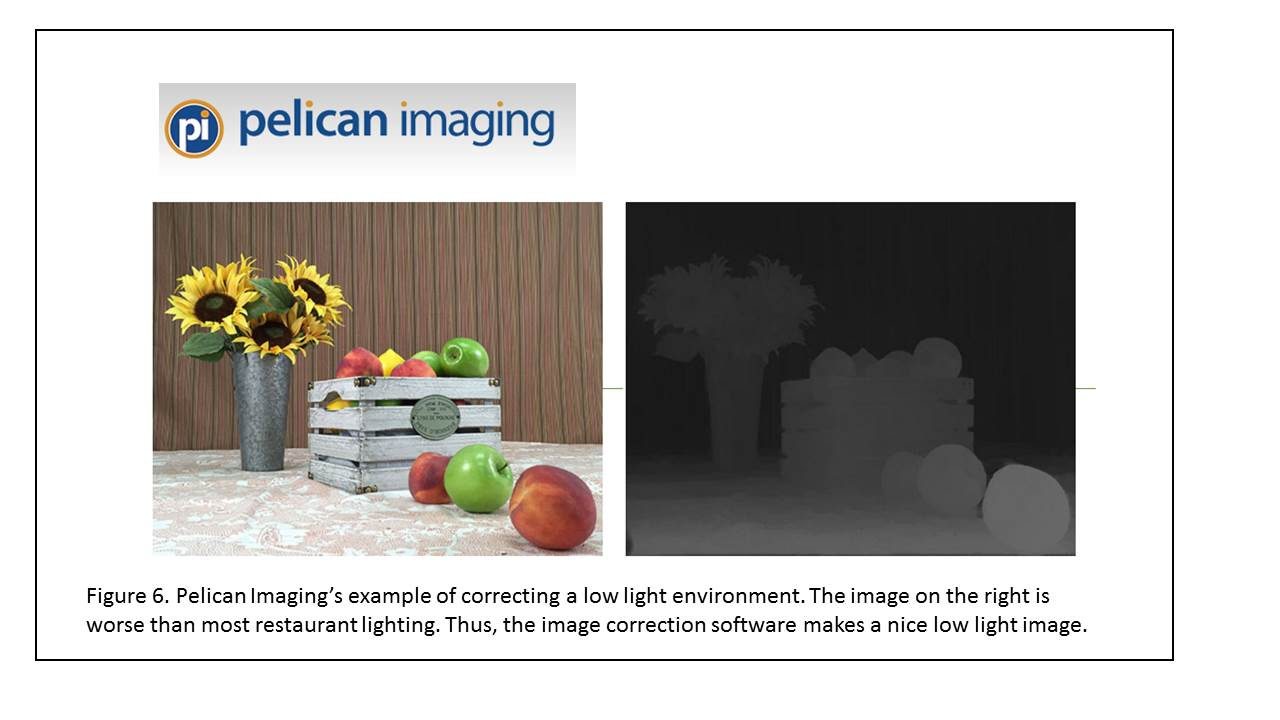
The real advantage of multiple image capture points is you can decide later how to focus the image. You can select a point in the rear to be in focus, let the entire image be in focus or blur the background like can do with a DSLR camera.
One final area of analysis concerns video. It’s amazing the latest smartphone cameras can all take 4K video. Our current HD TVs are 1K resolution. The new capture is 2K x 2K, which is called 4K and represents how much better the image is than with HD. All video players can adjust a 4K video to play on a 1K HD TV. But, you can either play the video on new high resolution display such as the iMac to see the additional quality.
It won’t be too long before the smartphone can take as good photos and videos as DSLR with the difference being that you can only add many (professional quality) lenses to the DSLRs. A number of accessory companies are providing larger zoom lenses for use with a smartphone. However, it is likely better to use a DSLR in these situations in order to capture the video and photos in more realistic and easy to manage situations.
So, get ready. Advanced smartphone cameras and associated image processing are going to make taking photos with smartphones as good as other, larger and more expensive cameras.

J. Gerry Purdy, Ph.D. is the principal analyst with Mobilocity LLC and a research affiliate with Frost & Sullivan. He is a nationally recognized industry authority who focuses on monitoring and analyzing emerging trends, technologies, and market behavior in mobile computing and wireless data communications devices, software and services. Dr. Purdy is an “edge of network” analyst looking at devices, applications and services as well as wireless connectivity to those devices. Dr. Purdy provides critical insights regarding mobile and wireless devices, wireless data communications, and connection to the infrastructure that powers the data in the wireless handheld. Dr. Purdy continues to be affiliated with the venture capital industry as well. He spent five years as a venture advisor for Diamondhead Ventures in Menlo Park where he identified, attracted and recommended investments in emerging companies in the mobile and wireless industry. He has had a prior affiliation with East Peak Advisors and, subsequently, following their acquisition, with FBR Capital Markets. Dr. Purdy advises young companies who are preparing to raise venture capital. Dr. Purdy has been a member of the Program Advisory Board of the Consumer Electronics Association that produces CES, one of the largest trade shows in the world. He is a frequent moderator at CTIA conferences and GSM Mobile World Congress. Prior to funding Mobilocity, Dr. Purdy was chief mobility analyst with Compass Intelligence. Prior to that, he owned MobileTrax, LLC and enjoyed successful stints at Frost & Sullivan, Dataquest (a division of Gartner) among other companies.
Editor’s Note: Welcome to Analyst Angle. We’ve collected a group of the industry’s leading analysts to give their outlook on the hot topics in the wireless industry.

